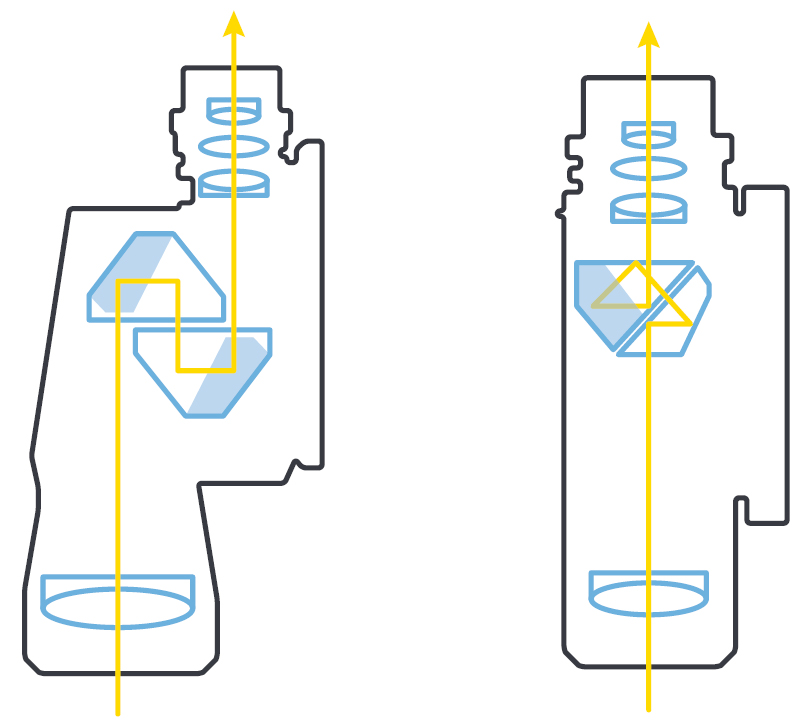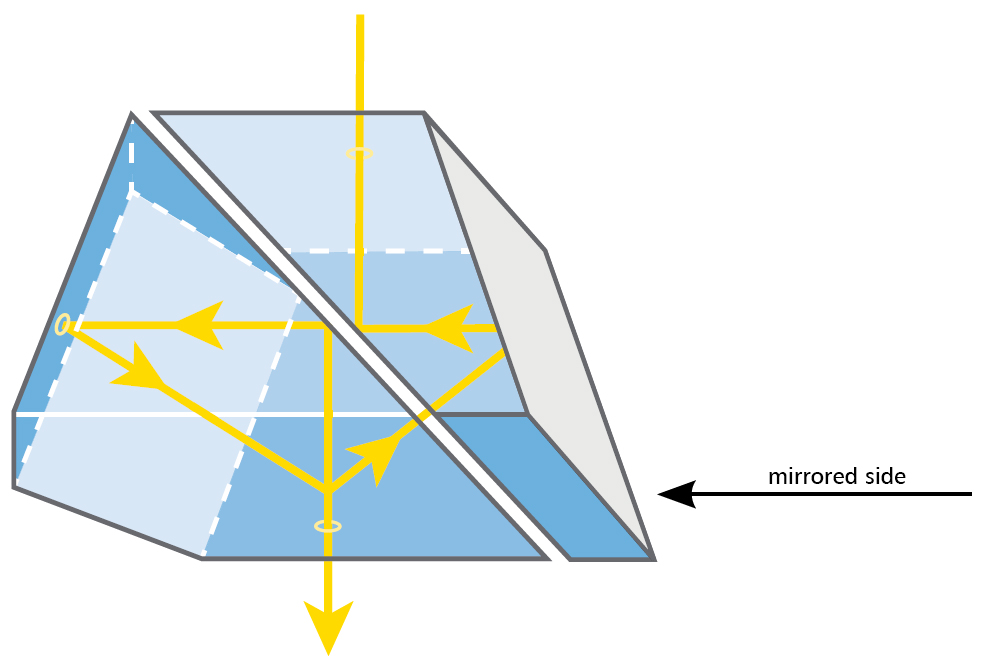General optical design
Lens, inverting system and eyepiece – the key elements found in all binoculars. Each component has its own special job: The lens generates an image in the intermediate image plane of the object observed. In general, this image – as with all real optical images – is upside down and reversed.
Therefore, the inverting system is positioned in front of the intermediate image plane. It switches top and bottom, left and right when light passes. This results in an upright, unreversed image. Prisms are used on binoculars and spotting scopes; lens elements on riflescopes. In principle, an eyepiece as a magnifier and helps the eye see the intermediate image.

Complex design
Theoretically, one converging lens for the lens and eyepiece each is enough but the result would be unsatisfactory. Therefore, sophisticated systems have been developed which contain, for example, 17 lens elements for spotting scopes with zoom eyepieces.
Different glass materials with varying properties are also combined (including the very high-quality optical fluoride glass for ZEISS FL products) to achieve brilliant, outstanding results. The many coatings applied to all glass surfaces in a high vacuum and, of course, extremely stringent tolerances in the manufacture of the single parts and during assembly play a key role as well.
Prism systems
Even if prisms are responsible for the upright image “only“, they play an important and decisive role in the shape of the housing and image quality of binoculars. Two systems are primarily used today.
Porro and roof prisms
Binoculars with Porro prisms are relatively wide with lenses farther apart than the eyepieces. Porro binoculars work like traditional “field glasses“. Binoculars with roof prisms are slimmer; incoming and outgoing light rays show no or very little displacement. Almost all high quality, state-of-the-art binoculars use roof prisms.

Right: Beam path in a pair of binoculars with a roof prism system.
Accuracy of roof prisms
Their space-saving properties are the result of using both “sides of the roof” twice as reflective surfaces. The accuracy of these two plane surfaces and the 90° angle between them is, therefore, extremely vital. This also applies to the roof edge: it must have a perfectly sharp edge as any rounding results in stray light and reflections. Running a finger over the prism makes it unusable.
P coating
To achieve high image quality, a special coating must be applied to both roof surfaces. This so called“ phase-correction coating introduced by Carl Zeiss at the end of the 1980s prevents wave-optical effects (phase shifting) that would otherwise result in a reduction of detail resolution. All roof prisms of Carl Zeiss include this P coating today.
Schmidt-Pechan prisms
Roof prisms are usually used in two versions: the Schmidt-Pechan design is the smaller of the two and allows shorter designs but requires a mirror coating on one surface. However, each mirror absorbs several percent of the light unlike total reflection that otherwise occurs inside the prism. If the objective is then maximum image brightness, the Abbe-König design is preferred.

ZEISS binoculars with the Schmidt-Pechan prism:
Abbe-König prisms
The Abbe-König system is more elaborate, more expensive and somewhat longer but does not require the additional light-swallowing mirror and, therefore, results in brighter images. Therefore, all twilight-capable binoculars of Carl Zeiss include Abbe-König systems which is unique among premium binoculars. It is no wonder then that they are considered the brightest binoculars on the global market.
Dielectric mirror coating
The smaller Schmidt-Pechan systems with generally somewhat lower light transmission are used in the compact ZEISS Victory binoculars up to a lens diameter of 32 mm. To eliminate this “deficiency” a special dielectric mirror coating was developed, which consists of more than 70 layers and applied in a vacuum. It replaces the otherwise common, loss-prone silver coating and therefore matches properties very close to the extremely high transmission properties of the Abbe-König prisms.
ZEISS binoculars with Abbe-König prism:

Porro prisms
Unlike roof prisms, Porro prisms are easier to manufacture and generally enable very good transmission because they do not require a mirror coating. However, they are large and heavy. Because of their design, watertight binoculars with internal focusing are also very difficult to implement.

The better “three-dimensional observation“ through the widely separated lenses is often doubted in many cases. At long ranges, a 2 to 3 cm additional lens spacing does not have a noticeable influence on depth perception.